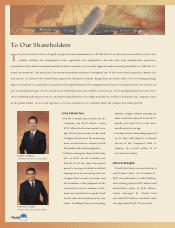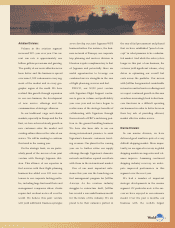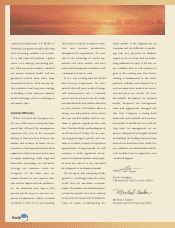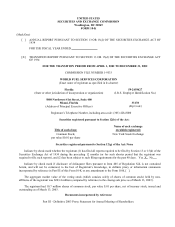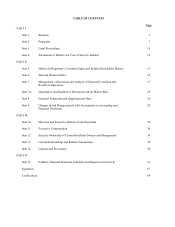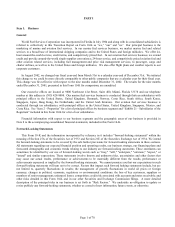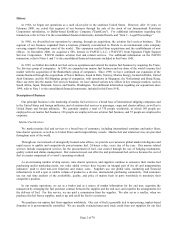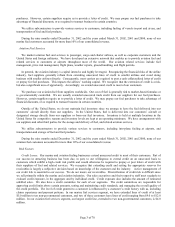World Fuel Services 2002 Annual Report Download - page 13
Download and view the complete annual report
Please find page 13 of the 2002 World Fuel Services annual report below. You can navigate through the pages in the report by either clicking on the pages listed below, or by using the keyword search tool below to find specific information within the annual report. We continuously review the adequacy of our insurance coverage. However, we lack coverage for various risks,
including environmental claims. An uninsured claim arising out of our activities, if successful and of sufficient magnitude,
will have a material adverse effect on our financial position and results of operations.
Regulation
Our activities, including discontinued operations, are subject to substantial regulation by federal, state and local
government agencies, both in and outside the United States, which enforce laws and regulations governing the transportation,
sale, storage and disposal of fuel and the collection, transportation, processing, storage, use and disposal of hazardous
substances and wastes, including waste oil and petroleum products.
The principal laws and regulations affecting our businesses are as follows:
The Comprehensive Environmental Response, Compensation and Liability Act of 1980 (“Superfund” or “CERCLA”)
establishes a program for federally directed response or remedial actions with respect to the uncontrolled discharge of
hazardous substances, pollutants or contaminants, including waste oil, into the environment. The law authorizes the United
States federal government either to seek a binding order directing responsible parties to undertake such actions or authorizes
the United States federal government to undertake such actions and then to seek compensation for the cost of clean-up and
other damages from potentially responsible parties. The United States Congress established a federally managed trust fund,
commonly known as the Superfund, to fund response and remedial actions undertaken by the United States federal
government. The trust fund is used to fund federally conducted actions when no financially able or willing responsible party
has been found.
The Superfund Amendments and Re-authorization Act of 1986 (“SARA”) adopted more detailed and stringent standards
for remedial action at Superfund sites, and clarified provisions requiring damage assessments to determine the extent and
monetary value of injury to the environment. SARA also provides a separate funding mechanism for the clean-up of
underground storage tanks.
The Resource Conservation and Recovery Act of 1976 (“RCRA”) established a comprehensive regulatory framework for
the management of hazardous waste at active facilities. RCRA sets up a “cradle-to-grave” system for the management of
hazardous waste, imposing upon all parties who generate, transport, treat, store or dispose of waste, above certain minimum
quantities, requirements for performance, testing and record keeping. RCRA also requires permits for construction,
operation and closure of facilities and requires 30 years of post-closure care and monitoring. RCRA was amended in 1984 to
increase the scope of RCRA regulation of small quantity waste generators and waste oil handlers and recyclers; require
corrective action at hazardous waste facilities (including remediation at certain previously closed solid waste management
units); phase in restrictions on disposal of hazardous waste; and require the identification and regulation of underground
storage tanks containing petroleum and certain chemicals.
The Clean Water Act of 1972, as amended in 1987, establishes water pollutant discharge standards applicable to many
basic types of manufacturing plants and imposes standards on municipal sewage treatment plants. The act requires states to
set water quality standards for significant bodies of water within their boundaries and to ensure attainment and/or
maintenance of those standards. Most industrial and government facilities must apply for and obtain discharge permits,
monitor pollutant discharges, and under certain conditions reduce certain discharges.
The Safe Drinking Water Act, as amended in 1986, regulates public water supplies by requiring the EPA to establish
primary drinking water standards. These standards are likely to be further expanded under the EPA’s evolving groundwater
protection strategy which is intended to set levels of protection or clean-up of the nation’s groundwater resources. These
groundwater quality requirements will then be applied to RCRA facilities and CERCLA sites, and remedial action will be
required for releases of contaminants into groundwater.
The International Convention for the Prevention of Pollution from Ships (“MARPOL”) places strict limitations on the
discharge of oil at sea and in port and requires ships to transfer oily waste to certified reception facilities. The United States
Coast Guard has issued regulations effective March 10, 1986 which implement the requirements of MARPOL. Under these
regulations, each terminal and port of the United States that services oceangoing tankers or cargo ships over 400 gross tons
must be capable of receiving an average amount of oily waste based on the type and number of ships it serves. The reception
facilities may be fixed or mobile, and may include tank trucks and tank barges.
Page 5 of 70



